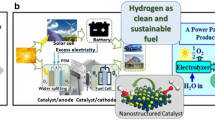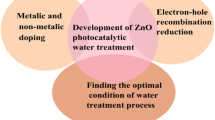Abstract
Zeolites are often used as supports for metals and metal oxides because of their well-defined microporous structure and high surface area. In this study, nano-zeolite Y (50–150 nm range) and micro-zeolite Y (500–800 nm range) were loaded with WO3, by impregnating the zeolite support with ammonium metatungstate and thermally decomposing the salt thereafter. Two different loadings of WO3 were studied, 3 wt.% and 5 wt.% with respect to the overall catalyst. The prepared catalysts were characterized for their morphology, structure, and surface areas through scanning electron microscope (SEM), XRD, and BET. They were further compared for their electrocatalytic activity for hydrogen evolution reaction (HER) in 0.5 M H2SO4. On comparing the bare micro-zeolite particles with the nano-form, the nano-zeolite Y showed higher currents with comparable overpotentials and lower Tafel slope of 62.36 mV/dec. WO3 loading brought about a change in the electrocatalytic properties of the catalyst. The overpotentials and Tafel slopes were observed to decrease with zeolite-3 wt.% WO3. The smallest overpotential of 60 mV and Tafel slope of 31.9 mV/dec was registered for nano-zeolite with 3 wt.% WO3, while the micro-zeolite gave an overpotential of 370 mV and a Tafel slope of 98.1 mV/dec. It was concluded that even with the same metal oxide loading, nano-zeolite showed superior performance, which is attributed to its size and hence easier escape of hydrogen bubbles from the catalyst.








Similar content being viewed by others
References
Anis, S. F., & Hashaikeh, R. (2016). Electrospun zeolite-Y fibers: fabrication and morphology analysis. Microporous and Mesoporous Materials, 233(Supplement C), 78-86
Anis SF, Khalil A, Singaravel G, Hashaikeh R (2016) A review on the fabrication of zeolite and mesoporous inorganic nanofibers formation for catalytic applications. Microporous Mesoporous Mater 236:176–192
Anis SF, Lalia BS, Mostafa AO, Hashaikeh R (2017a) Electrospun nickel–tungsten oxide composite fibers as active electrocatalysts for hydrogen evolution reaction. J Mater Sci 52(12):7269–7281. https://doi.org/10.1007/s10853-017-0964-2
Anis SF, Lalia BS, Palmisano G, Hashaikeh R (2018) Photoelectrochemical activity of electrospun WO3/NiWO4 nanofibers under visible light irradiation. J Mater Sci 53(3):2208–2220
Anis SF, Singaravel G, Hashaikeh R (2017b) Electropsun Ni-W/zeolite composite fibers for n-heptane hydrocracking and hydroisomerization. Mater Chem Phys 200:146–154
Chekin F, Bagherib S, Hamidb SBA (2013) Synthesis of tungsten oxide nanorods by the controlling precipitation reaction: application for hydrogen evolution reaction on a WO3 nanorods/carbon nanotubes composite film modified electrode. J Chin Chem Soc 60:447–451
Cheng H, Reinhard M (2006) Sorption of trichloroethylene in hydrophobic micropores of dealuminated Y zeolites and natural minerals. Environ Sci Technol 40(24):7694–7701. https://doi.org/10.1021/es060886s
Chica A (2013) Zeolites: promised materials for the sustainable production of hydrogen. ISRN Chem Eng 2013(19):1–19. https://doi.org/10.1155/2013/907425
Cruciani G (2006) Zeolites upon heating: factors governing their thermal stability and structural changes. J Phys Chem Solids 67(9–10):1973–1994. https://doi.org/10.1016/j.jpcs.2006.05.057
Dubey N, Labhsetwar NK, Devotta S, Rayalu SS (2007) Hydrogen evolution by water splitting using novel composite zeolite-based photocatalyst. Catal Today 129(3):428–434
Fox MA, Pettit TL (1989) Photoactivity of zeolite-supported cadmium sulfide: hydrogen evolution in the presence of sacrificial donors. Langmuir 5(4):1056–1061. https://doi.org/10.1021/la00088a032
García EJ, Pérez-Pellitero J, Pirngruber GD, Jallut C, Palomino M, Rey F, Valencia S (2014) Tuning the adsorption properties of zeolites as adsorbents for CO2 separation: best compromise between the working capacity and selectivity. Ind Eng Chem Res 53(23):9860–9874
Gong M, Zhou W, Tsai M-C, Zhou J, Guan M, Lin M-C et al (2014) Nanoscale nickel oxide/nickel heterostructures for active hydrogen evolution electrocatalysis. Nat Commun 5:4695
Jensen NK, Rufford TE, Watson G, Zhang DK, Chan KI, May EF (2011) Screening zeolites for gas separation applications involving methane, nitrogen, and carbon dioxide. J Chem Eng Data 57(1):106–113
Kadyk, T., Bruce, D., & Eikerling, M. (2016). How to enhance gas removal from porous electrodes?, 6, 38780. doi: https://doi.org/10.1038/srep38780
Lalia BS, Ahmed FE, Shah T, Hilal N, Hashaikeh R (2015a) Electrically conductive membranes based on carbon nanostructures for self-cleaning of biofouling. Desalination 360:8–12
Lalia BS, Khalil A, Shah T, Hashaikeh R (2015b) Flexible carbon nanostructures with electrospun nickel oxide as a lithium-ion battery anode. Ionics 21(10):2755–2762. https://doi.org/10.1007/s11581-015-1482-3
Lalia BS, Shah T, Hashaikeh R (2015c) Microbundles of carbon nanostructures as binder free highly conductive matrix for LiFePO4 battery cathode. J Power Sources 278:314–319. https://doi.org/10.1016/j.jpowsour.2014.12.079
Li M (2007) Peak oil, the rise of China and India, and the global energy crisis. J Contemp Asia 37(4):449–471
Li YH, Liu PF, Pan LF, Wang HF, Yang ZZ, Zheng LR et al (2015) Local atomic structure modulations activate metal oxide as electrocatalyst for hydrogen evolution in acidic water. Nat Commun 6(6):8064. https://doi.org/10.1038/ncomms9064
Lin Y, Liu M, Pan Y, Zhang J (2017) Porous Co–Mo phosphide nanotubes: an efficient electrocatalyst for hydrogen evolution. J Mater Sci 52(17):10406–10417
Liu J, Jiang G, Liu Y, Di J, Wang Y, Zhao Z et al (2014) Hierarchical macro-meso-microporous ZSM-5 zeolite hollow fibers with highly efficient catalytic cracking capability. Sci Rep 4
Luo Z, Miao R, Huan TD, Mosa IM, Poyraz AS, Zhong W et al (2016) Mesoporous MoO3–x material as an efficient electrocatalyst for hydrogen evolution reactions. Adv Energy Mater 6(16)
Meng Z-D, Zhu L, Choi J-G, Park C-Y, Oh W-C (2011) Preparation, characterization and photocatalytic behavior of WO3-fullerene/TiO2 catalysts under visible light. Nanoscale Res Lett 6(1):459. https://doi.org/10.1186/1556-276x-6-459
Mentus S, Mojovic Z, Cvjeticanin N, Tesic Z (2003) Hydrogen evolution on zeolite supported platinum clusters. Fuel Cells 3(1–2):15–20. https://doi.org/10.1002/fuce.200320240
Mentus S, Mojovic Z, Cvjeticanin N, Tesic Z (2004) Electrochemical water splitting on zeolite supported platinum clusters. J New Mater Electrochem Syst 7(3):213–220. https://www.scopus.com/record/display.uri?eid=212-s212.210-13444267823&origin=inward&txGid=13444267823aad13444267374f13444267871ddc13444240354a13444267847fdbf13444267821e13444267214d13444267828
Momirlan M, Birjega R (1997) Structure of zeolites used in hydrogen evolution from water. Int J Hydrog Energy 22(12):1133–1136
Rajeswari J, Kishore P, Viswanathan B, Varadarajan T (2007) Facile hydrogen evolution reaction on WO3 nanorods. Nanoscale Res Lett 2(10):496–503. https://doi.org/10.1007/s11671-007-9088-y
Shevade S, Ford RG (2004) Use of synthetic zeolites for arsenate removal from pollutant water. Water Res 38(14):3197–3204
T.K. Shah, Basantkumar, H. Liu, C. A. Fleischer, J.J. Sedlak, J.M. Patel, W.P. Burgess, J.M. (2013)
Wang N, Sun Q, Bai R, Li X, Guo G, Yu J (2016) In situ confinement of ultrasmall Pd clusters within nanosized silicalite-1 zeolite for highly efficient catalysis of hydrogen generation. J Am Chem Soc 138(24):7484–7487. https://doi.org/10.1021/jacs.6b03518
Yan X, Tian L, Chen X (2015) Crystalline/amorphous Ni/NiO core/shell nanosheets as highly active electrocatalysts for hydrogen evolution reaction. J Power Sources 300:336–343. https://doi.org/10.1016/j.jpowsour.2015.09.089
Yue P, Khan F (1991) Methods for increasing photo-assisted production of hydrogen over titanium exchanged zeolites. Int J Hydrog Energy 16(9):609–613
Zhang B, Zhu H, Zou M, Liu X, Yang H, Zhang M et al (2017) Design and fabrication of size-controlled Pt–Au bimetallic alloy nanostructure in carbon nanofibers: a bifunctional material for biosensors and the hydrogen evolution reaction. J Mater Sci 52(13):8207–8218
Zhang D, Zeng K (2012) Evaluating the behavior of electrolytic gas bubbles and their effect on the cell voltage in alkaline water electrolysis. Ind Eng Chem Res 51(42):13825–13832. https://doi.org/10.1021/ie301029e
Zheng H, Mathe M (2011) Hydrogen evolution reaction on single crystal WO 3/C nanoparticles supported on carbon in acid and alkaline solution. Int J Hydrog Energy 36(3):1960–1964
Zhuman B (2017) Thesis: the use of carbon nanostructures as a binding material for zeolite particles and the evaluation of their catalytic performance. (MSc), Masdar Institute of Science and Technology, Abu Dhabi, UAE
Zou S, Liu J, Kobayashi H, Chen C, Qiao P, Li R et al (2017) Boosting hydrogen evolution activities by strong interfacial electronic interaction in ZnO@ Bi (NO3) 3 core–shell structures. J Phys Chem C 121(8):4343–4351
Acknowledgements
The authors would like to acknowledge the ADNOC Refining Research Centre (ARRC), Abu Dhabi, for partially funding this work.
Author information
Authors and Affiliations
Corresponding author
Ethics declarations
Conflict of interest
The authors declare that they have no conflict of interest.
Electronic supplementary material
(MP4 3378 kb).
(MP4 1346 kb).
Rights and permissions
About this article
Cite this article
Anis, S.F., Hashaikeh, R. Electrochemical water splitting using nano-zeolite Y supported tungsten oxide electrocatalysts. J Nanopart Res 20, 47 (2018). https://doi.org/10.1007/s11051-018-4153-2
Received:
Accepted:
Published:
DOI: https://doi.org/10.1007/s11051-018-4153-2




